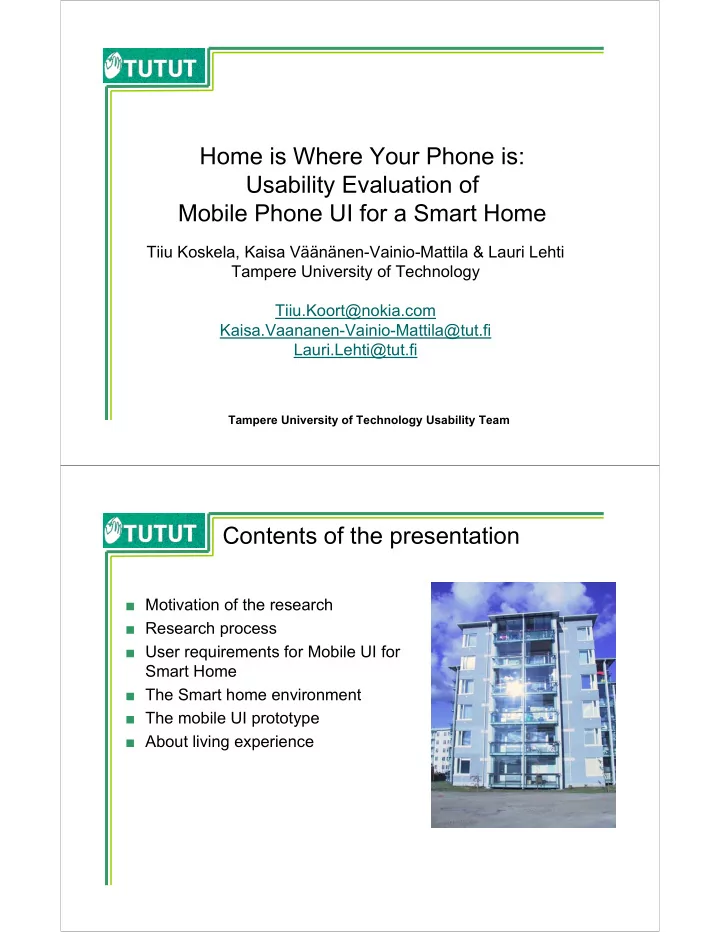

Home is Where Your Phone is: Usability Evaluation of Mobile Phone UI for a Smart Home Tiiu Koskela, Kaisa Väänänen-Vainio-Mattila & Lauri Lehti Tampere University of Technology Tiiu.Koort@nokia.com Kaisa.Vaananen-Vainio-Mattila@tut.fi Lauri.Lehti@tut.fi Tampere University of Technology Usability Team Contents of the presentation ■ Motivation of the research ■ Research process ■ User requirements for Mobile UI for Smart Home ■ The Smart home environment ■ The mobile UI prototype ■ About living experience
Motivation for the research ■ By ”smart home” we mean intelligent environment which provides user with means to perform everyday tasks ■ Research of Smart Homes is moving towards Ubiquitous Computing ■ Homes are built with time � How does the Mobile Phone UI answer to the users’ demands for the evolving Smart Home concept? Our research process ■ Definition phase: – Requirements for user interfaces – Contextual inquiry, theme interviews, focus groups – Young adults, families with children, middle-aged couples, elderly people (total of 22 subjects) ■ Design phase: – User interface prototypes – Iterative design, heuristic analysis, usability tests – Five young adults as test users ■ Evaluation phase: – Living experience in smart home over three months – Contextual Interviews, participatory walkthroughs – Young couple, non-technical
Definition phase: User requirements for Mobile UI User needs/wants Requirements to the mobile UI Centralised remote control. Support remote and centralised usage. Efficient task performance that fit Flexible and mobile interaction with to user’s own usage patterns. interruptions enabled. Enable the “feeling of control”. Easy, consistent and familiar interaction. Guided task-performance. Give information about the available actions and clear feedback. Visual information preferable. Home is a place to belong. Support switching between privacy and togetherness. Personality (and mobility) Personal interaction device or identification of different users (e.g. usage of user profiles) Design phase: Smart Home Environment ■ Standard two-room apartment with basic infrastructure for smart home ■ Three UI prototypes: – Graphical UI with direct object manipulation on PC (laptop) – Menu based UI on Media terminal (attached to TV) – Menu based UI on Mobile Phone PC, GUI Media terminal Mobile Phone ■ Control lights ■ Control lights ■ Control lights ■ Control curtains ■ Control curtains ■ Control curtains ■ Monitor plants ■ Monitor plants ■ Monitor electrical ■ Monitor electrical appliances appliances
Design phase: Mobile phone UI prototype Evaluation phase: About living experience ■ Need for Instant Control while at home – Make and break the rules – Instant Control: “right here and now” ■ Need to ensure secure and pleasant home from a distance – “feel home” from the distance � Mobile phone UI answers to the needs – Always in the reach – Feeling of stand-by mode and immediate access – Mobile and personal controlling device
Appendix 1: UI prototype on PC Appendix 2: Media terminal UI Prototype
Recommend
More recommend